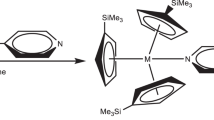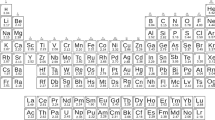Abstract
WE have made a systematic examination1 of the absorption spectra of cobaltammines which undergo isotopic exchange of hydrogen atoms in constituent NH3 or NH2 radicals, and more especially of those which are mixtures of optical isomers. Cobaltammines almost invariably give rise to two broad absorption bands2 in the visible (I) and near ultraviolet (II) spectrum. Substitution of 2H for 1H produces an effect upon band (I) illustrated in Fig. 1; it is generally more pronounced the larger the number of exchangeable hydrogen atoms in the molecular ion. Absorption band (II) is scarcely affected, but differences occur in the farther ultra-violet. The full line is representative of protium-containing cobaltammines, the broken line of corresponding deuterium compounds.
This is a preview of subscription content, access via your institution
Access options
Subscribe to this journal
Receive 51 print issues and online access
$199.00 per year
only $3.90 per issue
Buy this article
- Purchase on Springer Link
- Instant access to full article PDF
Prices may be subject to local taxes which are calculated during checkout
Similar content being viewed by others
References
Hamblin, F. T., thesis (1935). Poynton, N. H., thesis (1936).
Mead, Trans. Faraday Soc., 30, 1052 (1934).
J. Chim. Phys., 33, 78 (1936); Bull. Soc. Chim., 3, 476 (1936).
NATURE, 39, 109 and 508 (1937).
Author information
Authors and Affiliations
Rights and permissions
About this article
Cite this article
JOHNSON, C., POYNTON, N. Absorption Spectra, Optical Activity and Isotopic Exchange. Nature 139, 842–843 (1937). https://doi.org/10.1038/139842b0
Issue Date:
DOI: https://doi.org/10.1038/139842b0
Comments
By submitting a comment you agree to abide by our Terms and Community Guidelines. If you find something abusive or that does not comply with our terms or guidelines please flag it as inappropriate.



